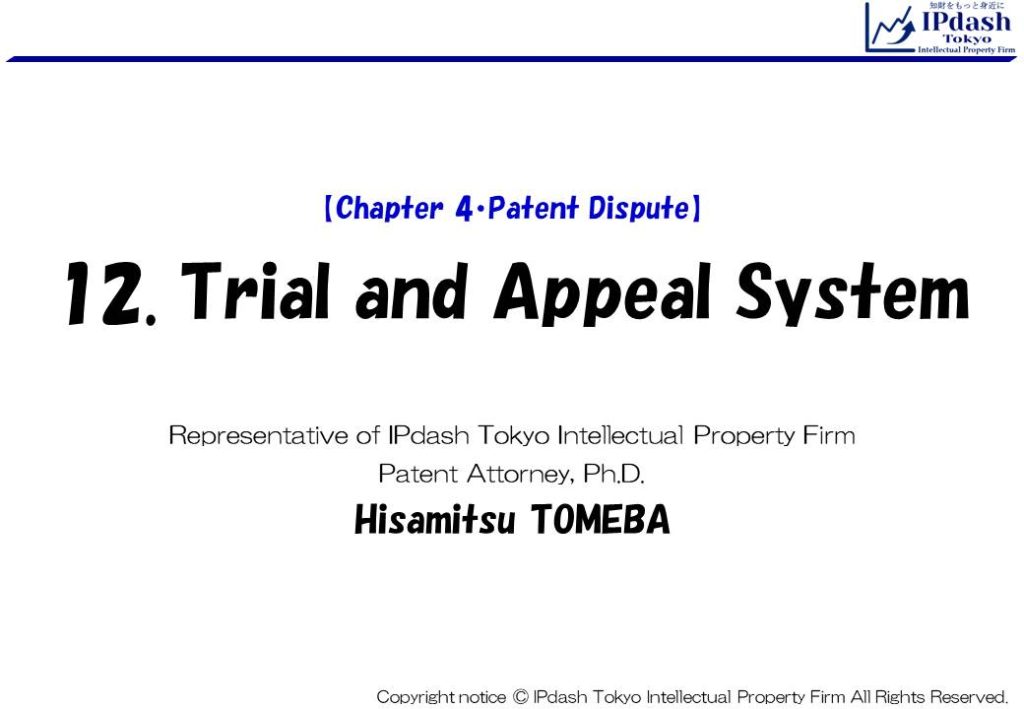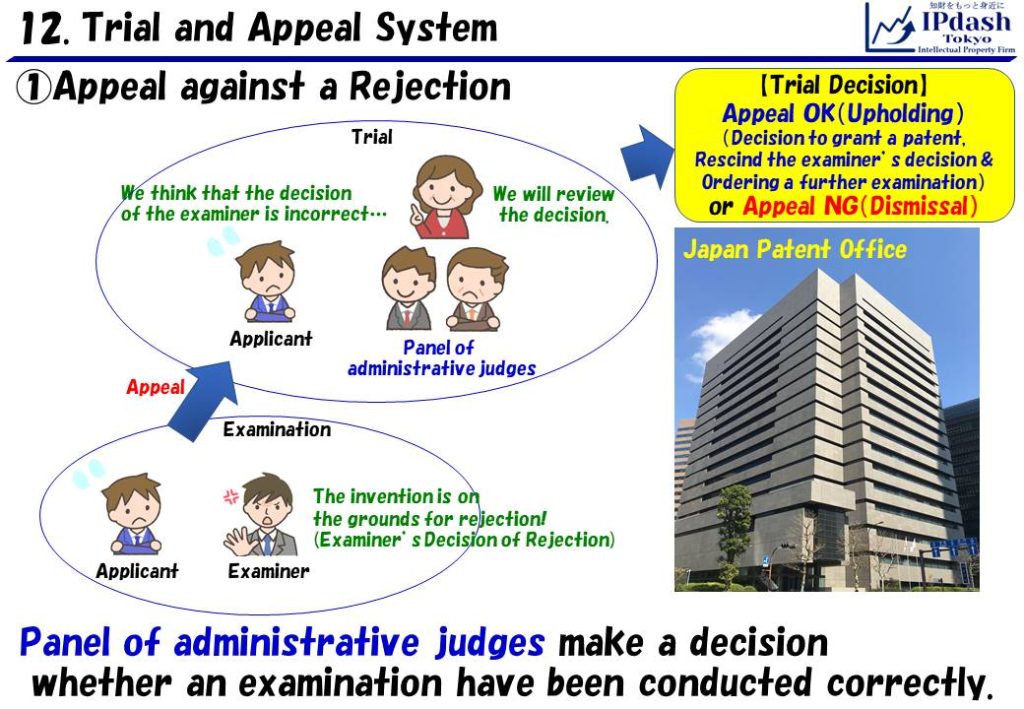
This is the 12th part of our seminar “Intellectual Property in Japan (Patent right)”.
“Trial and Appeal System” will be explained in an easy-to-understand manner with slides.
☆ ☆ ☆
The 4th chapter is “Patent dispute”.
Once patent infringement litigation occur, Trial for Patent Invalidation also proceed separately from the lawsuit in general.
Before talking about the relationship between litigation and trial, I would like to talk about Trial and Appeal system.

There are 4 kinds of trials in the Japanese Patent Act.
In short, Trial and Appeal is system to review disposition.
Panel of administrative judges is in charge of Trial and Appeal.
Let’s review each of them.
☆ ☆ ☆

The 1st topic is “Appeal against a Rejection”.
Here is one example (slide above).
As result of examination, applicant received an examiner’s decision of refusal.
However, he/she is dissatisfied with the result.
So, he/she has filed a request for a “trial against the examiner’s decision of refusal”.
In Appeal against a Rejection, administrative judges make a decision whether an examination have been conducted correctly.
☆ ☆ ☆
If administrative judges recognized that the grounds (on which the appeal is based) are reasonable, they uphold the appeal.
(Ex. There is a flaw in a determination.)
In this case, administrative judges grant a patent,
otherwise, rescind the examiner’s decision and order a further examination.
On the other hand, if administrative judges recognize that the examiner’s determination is reasonable, they dismiss the appeal.
☆ ☆ ☆

The 2nd topic is “Correction Trial”.
Slide above is an example.
Patentee found defects in their patent.
So he/she wishes to correct the description and eliminate the defects.
Therefore, he/she files a request for a “trial against the examiner’s decision of refusal”.
In Correction trial, administrative judges check whether the correction fulfill the conditions of correction.
☆ ☆ ☆
If there was a defect (such as a reason for invalidation) in a patent, it would be rescinded.
By correcting the description and eliminating the defect, patentee can avoid the rescission of patent.
“Correction Trial” is commonly called “Defense” method, because the trial can oppose “Trial for Patent Invalidation” commonly called “Offense” method.
When the petition of correction is upheld, the corrected claims (description) is granted to patent.
☆ ☆ ☆

To explain more clearly, image of the correction is shown in the slide above.
Please look at left of the image.
Patentee notice that the patent contains a publicly-known invention.
That is, the patent application had defects, but it was wrongly patented (Lack of novelty).
In this case, the patent holds reasons for invalidation as a whole.
That is, if the claim 2 has a patentability, the whole patent may be invalid.
☆ ☆ ☆
Therefore, patentee delete the claim 1 which contains a publicly-known invention in its scope (middle of the image).
Due to the correction, the scope of the right become smaller, but the defect of the patent is eliminated.
☆ ☆ ☆
Patent without defect in hand, patentee can exercise the right against patent infringers (right of the image).

The 3rd topic is “Trial for Patent Invalidation”.
The Trial for Patent Invalidation frequently appears in the patent dispute.
In this trial, the validity of a patent is disputed.
It takes a conflict structure such as “Requester vs. Patentee”.
☆ ☆ ☆
Once a decision that a patent is to be invalidated has become final and binding,
the patent right is deemed never to have existed (next slide).

Here is one example.
Timeline is as follows.
At first, Company A obtained a patent for invention alpha.
Company A found infringement of their patent by company B. (Company B works invention alpha as business.)
Company A exercise their right (Claim for damages) against company B.
As mentioned above, once a decision that a patent is to be invalidated has become final and binding, the patent right is deemed never to have existed.
That is, infringement of patent itself is deemed never to have existed.
From the viewpoint of alleged infringers, “If they won the decision that the patent is invalid, they could win the action for infringement.”
☆ ☆ ☆
Here, I would like to give you a question as a break.

Where is Trial for Patent Invalidation held?

It seems that it is held in a court because it is related to dispute.
However, Trial for Patent Invalidation is held in the Japan Patent Office.
Trial court in the Japan Patent Office will be introduced in the next slide.

This is a Configuration example of Trial court.
There are large rooms like a courthouse in the Japan Patent Office buildings.
Requester and respondent are seated facing each other.
Administrative judge (trial examiner) proceed a examination.
☆ ☆ ☆

The final (4th) topic is “Trial for Invalidation of Registration of Patent Term Extension”.
It takes a conflict structure such as “Requester vs. Patentee” too.
☆ ☆ ☆
In pharmaceutical and agrichemical field, business entity sometimes need time to obtain approval from authorities.
During that time, patentee can not work their invention.
Therefore, there is system that patentee can extend their patent term (up to 5 years).
In the Trial for Invalidation of Registration of Patent Term Extension, the validity of the extension is disputed.
☆ ☆ ☆
For example (slide above),
Company B (unwillingly) pay license fee every year for company A that holds extended patent (extension term: 5years).
If the extension term was 3 years, license fee (which company B should pay) would be decreased.
In those cases, “Trial for Invalidation of Registration of Patent Term Extension” is utilized.

I’d like to wrap up with a summary of this part.
1. In Appeal against a Rejection, an examination process is reviewed.
2. In Correction Trial, correction of the description in a patent is reviewed (Defense method).
3. In Trial for Patent Invalidation, validity of the patent
is reviewed (Offense method).
4. In Trial for Invalidation of Registration of Patent Term Extension, validity of the patent term extension is reviewed.
☆ ☆ ☆
Trial and Appeal System (Administrative Trial) may not be familiar in public.
If these slides became tip for your understandings, we would feel happy.
Trial and Appeal System will be referred to the following parts.
That’s all for Part 12 (Trial and Appeal System).
IPdash Tokyo Intellectual Property Firm (Japan)
(To Part 11) (To Part 13)
(To List)
